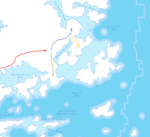History of Central Orient: Difference between revisions
No edit summary |
No edit summary |
||
| Line 10: | Line 10: | ||
Reviews of archaeological evidence have suggested that occupation of the subcontinent by hominins was sporadic until approximately 700,000 years ago, and was geographically widespread by approximately 250,000 years before the present, from which point onward, archaeological evidence of proto-human presence is widely mentioned. Modern {{wp|humans}} began migrating to the central Oriental region from [[Amutia]] and [[Azania]] with the earliest appearing in modern-day [[Mahana]] and [[Namdatka]] around 70,000 years ago. Evidence suggests that some then migrated into [[Kotowari]] and [[Mekabiri]] at around 65,000 years ago, and finally from [[Mekabiri]] into [[Tamurin]] around 60,000 years ago. | Reviews of archaeological evidence have suggested that occupation of the subcontinent by hominins was sporadic until approximately 700,000 years ago, and was geographically widespread by approximately 250,000 years before the present, from which point onward, archaeological evidence of proto-human presence is widely mentioned. Modern {{wp|humans}} began migrating to the central Oriental region from [[Amutia]] and [[Azania]] with the earliest appearing in modern-day [[Mahana]] and [[Namdatka]] around 70,000 years ago. Evidence suggests that some then migrated into [[Kotowari]] and [[Mekabiri]] at around 65,000 years ago, and finally from [[Mekabiri]] into [[Tamurin]] around 60,000 years ago. | ||
[[Orioni]]'s first evidence of humans derives from [[ | [[Orioni]]'s first evidence of humans derives from [[Marenesia]] rather than Azania like the rest of the [[Orient]], with settlers ariving to the Orinese Isles as late as 8,000 BCE. | ||
====Neolithic==== | ====Neolithic==== | ||
Settled life appeared earliest with the [[Ghobari Valley]] around 9,000 years ago. This evolved slowly into the more developed [[Ghobari Valley Civilisation]] not long after in the 6th millennium BCE, modern day [[Mahana]]. In and around the same time a fishing culture emerged in [[Mekabiri]]'s southern and eastern coasts, which also spread to [[Tamurin]]. | Settled life appeared earliest with the [[Ghobari Valley]] around 9,000 years ago. This evolved slowly into the more developed [[Ghobari Valley Civilisation]] not long after in the 6th millennium BCE, modern day [[Mahana]]. In and around the same time a fishing culture emerged in [[Mekabiri]]'s southern and eastern coasts, which also spread to [[Tamurin]]. | ||
Revision as of 19:22, 22 June 2022
| Part of a series on |
| Central Orient |
|---|
 |
This article is incomplete because it is pending further input from participants, or it is a work-in-progress by one author. Please comment on this article's talk page to share your input, comments and questions. Note: To contribute to this article, you may need to seek help from the author(s) of this page. |
The term "Central Orient" defines itself as a region of the Oriental sub-continent containing countries such as Orioni,Kotowari,Tamurin,Mekabiri,Mahana and Namdatka. The region also goes by other names such as the Kotowaran sub-continent or the Menelassar Bay region. The regions history is heavily intertwined with other countries outside the region such as colonial powers from Argis and Aurelia. Central Orient has historically had powers in Tamurin and Kotowari, which both had holdings over the rest of the region.
Timeline
Prehistoric Orient (Before c.3300 BCE)
Paleolithic
Reviews of archaeological evidence have suggested that occupation of the subcontinent by hominins was sporadic until approximately 700,000 years ago, and was geographically widespread by approximately 250,000 years before the present, from which point onward, archaeological evidence of proto-human presence is widely mentioned. Modern humans began migrating to the central Oriental region from Amutia and Azania with the earliest appearing in modern-day Mahana and Namdatka around 70,000 years ago. Evidence suggests that some then migrated into Kotowari and Mekabiri at around 65,000 years ago, and finally from Mekabiri into Tamurin around 60,000 years ago.
Orioni's first evidence of humans derives from Marenesia rather than Azania like the rest of the Orient, with settlers ariving to the Orinese Isles as late as 8,000 BCE.
Neolithic
Settled life appeared earliest with the Ghobari Valley around 9,000 years ago. This evolved slowly into the more developed Ghobari Valley Civilisation not long after in the 6th millennium BCE, modern day Mahana. In and around the same time a fishing culture emerged in Mekabiri's southern and eastern coasts, which also spread to Tamurin.
Agriculture began to become centralised in the Ghobari Valley Civilisation by 5,500 BCE, according to evidence in the region.
